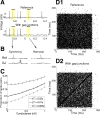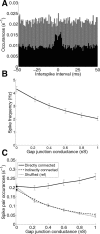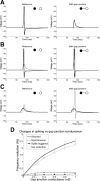Gap junctions between striatal fast-spiking interneurons regulate spiking activity and synchronization as a function of cortical activity
- PMID: 19386924
- PMCID: PMC2744332
- DOI: 10.1523/JNEUROSCI.6031-08.2009
Gap junctions between striatal fast-spiking interneurons regulate spiking activity and synchronization as a function of cortical activity
Abstract
Striatal fast-spiking (FS) interneurons are interconnected by gap junctions into sparsely connected networks. As demonstrated for cortical FS interneurons, these gap junctions in the striatum may cause synchronized spiking, which would increase the influence that FS neurons have on spiking by the striatal medium spiny (MS) neurons. Dysfunction of the basal ganglia is characterized by changes in synchrony or periodicity, thus gap junctions between FS interneurons may modulate synchrony and thereby influence behavior such as reward learning and motor control. To explore the roles of gap junctions on activity and spike synchronization in a striatal FS population, we built a network model of FS interneurons. Each FS connects to 30-40% of its neighbors, as found experimentally, and each FS interneuron in the network is activated by simulated corticostriatal synaptic inputs. Our simulations show that the proportion of synchronous spikes in FS networks with gap junctions increases with increased conductance of the electrical synapse; however, the synchronization effects are moderate for experimentally estimated conductances. Instead, the main tendency is that the presence of gap junctions reduces the total number of spikes generated in response to synaptic inputs in the network. The reduction in spike firing is due to shunting through the gap junctions; which is minimized or absent when the neurons receive coincident inputs. Together these findings suggest that a population of electrically coupled FS interneurons may function collectively as input detectors that are especially sensitive to synchronized synaptic inputs received from the cortex.
Figures







References
-
- Aertsen AMHJ, Gerstein GL, Habib MK, Palm G. Dynamics of neuronal firing correlation: modulation of “effective connectivity.”. J Neurophysiol. 1989;61:900–917. - PubMed
-
- Bar-Gad I, Morris G, Bergman H. Information processing, dimensionality reduction and reinforcement learning in the basal ganglia. Prog Neurobiol. 2003;71:439–473. - PubMed
-
- Bennett BD, Bolam JP. Synaptic input and output of parvalbumin-immunoreactive neurons in the neostriatum of the rat. Neuroscience. 1994;62:707–719. - PubMed
Publication types
MeSH terms
Grants and funding
LinkOut - more resources
Full Text Sources
Molecular Biology Databases
Research Materials
Miscellaneous
